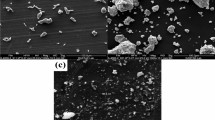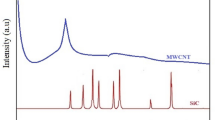Abstract
Minor additions of reactive elements (Y, Ce, La, Zr, Hf, etc.) significantly affect the high-temperature oxidation behavior of protective oxide scales. Designing oxidation-resistant aluminide coatings having optimum content of reactive elements is challenging due to the observed hindering effect of these elements on the coating formation. In the current investigation, this effect has been studied by examination of a high activity aluminide coating in powder mixtures of Al, NH4Cl, Y2O3, and Al2O3 with different Y2O3 contents. Oxides of Zr, Ce, and La were also examined for comparison. Cross-sectional microstructure of coatings and weight changes of the specimens were studied at different aluminizing times. The results showed that the inhibition effect applied for all reactive elements under investigation with different strengths and intensifies with more additions of Y2O3 up to a saturation limit. The observed inhibition effect was explained based on the equilibrium amounts of gaseous halides responsible for transfer of coating elements. It was demonstrated that the addition of Y2O3 can decrease the amount of aluminum carrier halide significantly. The mechanism of inhibition was attributed to the large agglomerates rich in aluminum and reactive elements detected in the pack after aluminizing treatment.






Similar content being viewed by others
References
W. Chen, L. He, Y. Guo, X. Shan, J. Li, F. Guo, X. Zhao, N. Ni, and P. Xiao, Surf. Coat. Technol., 2019, vol. 357, pp. 322-31. https://doi.org/10.1016/j.surfcoat.2018.10.021.
C. Quan, S. Deng, Y. Jiang, C. Jiang, M. Shuai, J. Alloys Compd., 2019, vol. 793, pp. 170-78. https://doi.org/10.1016/j.jallcom.2019.04.063.
D. Naumenko and B. A. Pint, W. J. Quadakkers, Oxid. Met., 2016, vol. 86, pp. 1-43. https://doi.org/10.1007/s11085-016-9625-0
J. Kipkemoi and D. Tsipas, J. Mater. Sci., 1996, vol. 31, pp. 6247–50. https://doi.org/10.1007/BF00354445
F. Pedraza, A. D. Kennedy, J. Kopecek, and P. Moretto, Surf. Coat. Technol., 2006, vol. 200, pp. 4032– 39. https://doi.org/10.1016/j.surfcoat.2004.12.019
K. Godlewski and E.Godlewska, Oxid. Met., 1986, vol. 26, pp. 125-38. https://doi.org/10.1007/BF00664277
K. Shirvani, M. Saremi, A. Nishikata, and T. Tsuru, Mater. Trans. A, 2002, vol. 43A, pp. 2622 – 28.
Y. Zhou, X. Zhao, C. Zhao, W. Hao, X. Wang, and P. Xiao, Corros. Sci., 2017, vol. 123, pp. 103–115. https://doi.org/10.1016/j.corsci.2017.04.008
L. Qian, F. Xu, K. T. Voisey, V. Nekouie, Z. Zhou, V. V. Silberschmidt, and X. Hou, Surf. Coat. Technol., 2017, vol. 311, pp. 238–247. https://doi.org/10.1016/j.surfcoat.2016.12.106
X. Tan, X. Peng, F. Wang, Surf. Coat. Technol., 2013, vol. 224, pp. 62–70. https://doi.org/10.1016/j.surfcoat.2013.03.003
J. Wen, L. Yang, L. Zhu, J. Zhang, and Q.-A. Li, Mater. Sci. Eng. A, 2009, vol. 499, pp. 123–125. https://doi.org/10.1016/j.msea.2007.11.139
M. Safari, F. Shariari-Nogorani, Surf. Coat. Technol., 2017, vol. 329, pp. 218–223. https://doi.org/10.1016/j.surfcoat.2017.09.035
M. Mobin, H. K. Sharma, and S. K. Hasan, Anti-Corros. Method Mater., 2002, vol. 49, pp. 283–294. https://doi.org/10.1108/00035590210439757
R. Bianco and R. A. Rapp, J. Electrochem. Soc., 1993, vol. 140, pp. 1181–1190. https://doi.org/10.1149/1.2056219
X. Zhao and C. Zhou, Corros. Sci., 2014, vol. 86, pp. 223–230. https://doi.org/10.1016/j.corsci.2014.05.018
H. Zahedi, F. Shahriari-Nogorani, and M. Safari, Met. Mater. Int., 2019. https://doi.org/10.1007/s12540-019-00483-0.
M. S. Zare-Mohazabie, and F. Shahriari-Nogorani, Surf. Coat. Technol., 2019, vol. 378, 125066. https://doi.org/10.1016/j.surfcoat.2019.125066.
Z. D. Xiang, J. S. Burnell-Gray, and P. K. Datta, J. Mater. Sci., 2001, vol. 36, pp. 5673–82. https://doi.org/10.1023/A:1012534220165
G. W. Goward and D. H. Boone, Oxid. Met., 1971, vol. 3, pp. 475–495. https://doi.org/10.1007/BF00604047
D. K. Das, V. Singh, and S. V. Joshi, Metall. Mater. Trans. A, 1998, vol. 29A, pp. 2173–88. https://doi.org/10.1007/s11661-998-0042-0
B. Nciri and L. Vandenbulcke, Thin Solid Films, 1986, vol. 139, pp. 311-324. https://doi.org/10.1016/0040-6090(86)90060-X
G.H. Marijnissen, H.V. Gameron, and J.A. Klosterman: Proceedings of High Temperature Alloys for Gas Turbines, D. Coutsouradis, P. Felix, H. Fischmeister, eds., Applied Science Publishers, pp. 231–38, 1978.
Z. D. Xiang and P. K. Datta, Acta Mater., 2006, vol. 54, pp. 4453–63. https://doi.org/10.1016/j.actamat.2006.05.032
S. R. Levine, and R. M. Caves, J. Electrochem. Soc., 1974, vol. 121, pp. 1051-64. https://doi.org/10.1149/1.2401976
Acknowledgments
The authors appreciate Department of Materials Science and Engineering, Shiraz University of Technology for providing the research facilities.
Author information
Authors and Affiliations
Corresponding author
Additional information
Publisher's Note
Springer Nature remains neutral with regard to jurisdictional claims in published maps and institutional affiliations.
Manuscript submitted May 9, 2020.
Rights and permissions
About this article
Cite this article
Ebadi, F., Shahriari Nogorani, F. & Fatemi, F. The Inhibiting Effect of Reactive Element Oxides on the Pack Cementation Aluminide Coating Formation. Metall Mater Trans A 51, 5958–5964 (2020). https://doi.org/10.1007/s11661-020-05973-0
Received:
Accepted:
Published:
Issue Date:
DOI: https://doi.org/10.1007/s11661-020-05973-0




